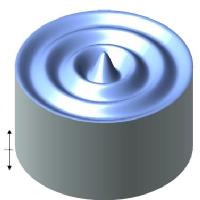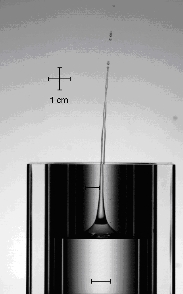Breaking of gravity waves parametrically forced in a circular cylinder
Large amplitude sloshing in containers is encountered in rocket engine fuel tanks and ship tanks. In these applications it is important to be able to predict the forces exerted by the sloshing motion on the tank walls as well as the consequences of sloshing and wave breaking on interfacial heat and mass transfer. However, large amplitude waves and wave breaking conditions especially of gravity waves aren't much described in the litterature.
Here we study sloshing motions inside a container subjected to vertical (along the axis) motions. Vertical forcing allows exciting axi-symmetric as well as asymmetric wave modes depending on forcing frequency. Axi-symmetric wave breaking can be very violent, leading to geyser formation (Zeff et al. 2000).
Experimental conditions:
Experiments are conducted in a circular cylinder of 5 cm in diameter and 6 cm in height. It is mounted on a vertically vibrating table that is used in the frequency range 10 to 14 Hz and vibration amplitudes A= 0 to 1 mm. A fluid with low kinematic viscosity and low surface tension (σ) is used so that dissipation remains small. The liquid depth (h=3cm) is sufficient to satisfy asymptotically deepwater conditions. Measurements were made by visualizations and image analysis.
Results:
The experimentally determined stability threshold of the parametrically forced axi-symmetric gravity wave mode in low viscosity and low surface tension fluid in a circular cylinder is shown to be in good agreement with the HM theory. Bifurcations to other wave modes take place when the forcing frequency approaches the natural frequency of these modes. Stable wave motions exist between the stability threshold and the wave-breaking threshold established in the present experiments. The amplitude response curve shows that in a certain frequency range these stable waves exhibit amplitude modulations. In the unstable regime, a finite time singularity occurs with intense geyser or jet formation, a phenomenon demonstrated by Zeff et al. (2000) in fluids of high viscosity. Here this singularity is demonstrated for a low viscosity and low surface tension liquid. A dimensionless expression for the jet velocity is proposed that takes into account the container size in addition to the fluid properties (Das et al, CFM 2007 ![]() ).
).
SUPERVISOR : Prof. Emil J. Hopfinger, Emil.Hopfinger@hmg.inpg.fr
COWORKER : Dr Shyama P. Das, shyama.das@hmg.inpg.fr


